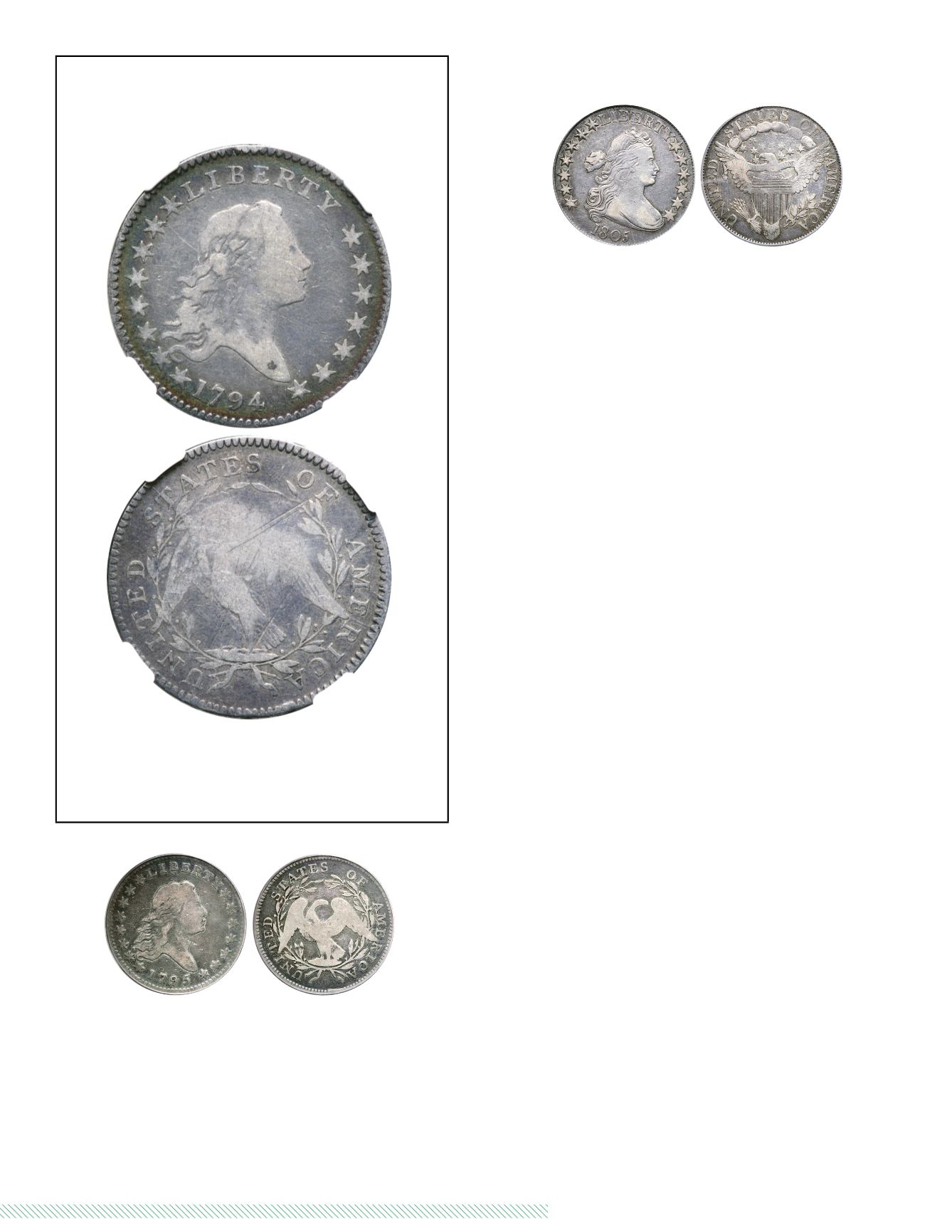
1
91
bid online at
(800) 978-COIN (2646)
|
Session Two - Sunday, June 1, 2014 Approx 12:00 PM
I
MPORTANT
1794 F
LOWING
H
AIR
H
ALF
D
OLLAR
474
1794 O-105 Rarity 5
.
NGC graded VF-20
. Nice even
toning. Some light reverse adjustment marks as made.
Estimated Value .................................... $16,000 - 18,000
475
1795 O-108, Rarity-4
.
PCGS graded Fine-12.
CAC
Approved
. Nice even toning, deep old-silver hue in the fields,
lighter accents on the chief devices give pleasing contrast. O-
108 has several points of interest including some die defect
marks at star 1, and a fine horizontal die crack from the milling
through star 15 to the end of the bust; on the reverse can be
found a small rim break before the right ribbon. Berries are
arranged 9 + 8, with two inside and one outside on the left, two
inside on the right where the upper one lacks a stem. (
PCGS #
6052
)
Estimated Value ..............................................$1,900 - 2,000
Enlargement
Dr aped Bus t Ha l f Do l l a r s
476
1805. Overton-109, Rarity 3
.
PCGS graded EF-40.
CAC
Approved
. A hint of tone. The year 1805 brought about a
renewal of production of half dollars with fourteen die varieties
and a total mintage of 211,722. Three of the seven obverse dies
were prepared for use in 1804 as the date was overpunched
with a 5 creating the 1805/4 overdates. The manufacture of
working dies from the master hub took about three days'effort,
and cost approximately $17 each to prepare according to the
Parsley/Overton reference on this extensive series of coins.
“Since the mint was working on a very small budget the waste
of approximately fifty dollars was not acceptable. The lack of
effort to remove the underlying 4 indicates that the mint was
much more concerned with efficiency than with accuracy of
dates.” It also seems that the prolonged use of dies was readily
visible in 1805 with major die cracks, breaks, and cuds apparent
on a number of specimens. Most varieties this year are rela-
tively common, and hence, suitable, indeed ideal, for Type Set
purposes.
On O-109, the same obverse as used in O-108 is carried over.
On it, star 13 touches the upper edge of the bust. On the
reverse, there are 4 berries on the branch, with a leaf joined to
the right base of I in AMERICA. ME very close.
Pop 77; 82
finer at PCGS for the variety.
(
PCGS # 6069
)
Estimated Value ..............................................$1,500 - 1,550
477
1806. Pointed 6, Stem. Overton-116, Rarity 3. PCGS
graded Genuine, Cleaning - VF Details
. Light gray toning.
The production of 1806 half dollars was in total more than the
total of all years prior, from 1794 to date. The 839,576 esti-
mated production included twenty-eight known die marriages,
although there is always a possibility more will be discovered.
The 1806 die varieties can be grouped into major types. The
obverses are classified by the punches used in the date. The
major types are knobbed top six and pointed top six. This
pointed top six is the only time this type of numeral punch was
used in the entire series to 1836. All of the other six and nine
punches have a knob. The knobbed top six obverse is also sub-
divided by size of stars, with large or small star punches used.
The reverses are group by the stem of the olive branch not
extending through the claw and later extending through the
claw. (
PCGS # 39319
)
Die notes: Double cut TY in LIBERTY as on O-114 & O-115 from
the same obverse, except that on O-116 not so much of the
recutting shows at the top of Y and the small defect near the
top of the 6 no longer shows. Five berries, the lowest one has
no stem and the upper two have heavy stems joined at base.
Estimated Value ................................................... $250 - 300


